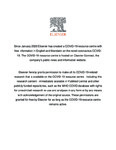A reformulated contextual model of psychotherapy for treating anxiety and depression
| dc.contributor.author | Hyland, Michael | |
| dc.date.accessioned | 2020-10-19T12:13:53Z | |
| dc.date.issued | 2020-08 | |
| dc.identifier.issn | 0272-7358 | |
| dc.identifier.issn | 1873-7811 | |
| dc.identifier.other | 101890 | |
| dc.identifier.uri | http://hdl.handle.net/10026.1/16560 | |
| dc.description.abstract |
This paper describes a reformulated contextual model that uses cognitive theory (dual process theory), motivation theory (personality) and behavioral adaptation (self-correcting control systems) to show how anxiety and depression are caused, treated and prevented by an interaction between people and contexts. Depression and anxiety are the result of implicit beliefs (not cognitions) that all experience is unrewarding and threatening, these being components of the implicit belief that life is bad. Implicit beliefs are formed automatically from contextual cues and in healthy individuals are consistent with rational appraisal. They become more negative than reality through a process of adaptation when behaviors, directed by rational thinking, repeatedly create cues that signify lack of reward or threat. Such behaviors occur when social or other obligations lead people to choose behaviors that fail to satisfy their own unique goals in life and approach threatening situations, contrary to their automatic reactions. Therapeutic interventions and lifestyle change reverse these adaptive processes by positive experiences that create positive implicit beliefs, a change effected in different ways by contextual and specific mechanisms both of which correct the same fault of negative implicit beliefs. Effective therapeutic relationships and interventions are achieved by detecting and responding to a patient's unique needs and goals and their associated implicit beliefs. Mental health requires not only that people experience life as good as defined by their own goals and beliefs but also the avoidance of contexts where social and other pressures induce people to behave in ways inconsistent with their automatically generated feelings. | |
| dc.format.extent | 101890-101890 | |
| dc.format.medium | Print-Electronic | |
| dc.language | en | |
| dc.language.iso | eng | |
| dc.publisher | Elsevier BV | |
| dc.subject | Common factors | |
| dc.subject | Contextual model | |
| dc.subject | Psychotherapy | |
| dc.subject | Dual process theory | |
| dc.subject | Connectionism | |
| dc.subject | Adaptation | |
| dc.subject | Mental health | |
| dc.subject | Depression | |
| dc.subject | Anxiety | |
| dc.subject | Prevention | |
| dc.title | A reformulated contextual model of psychotherapy for treating anxiety and depression | |
| dc.type | journal-article | |
| dc.type | Journal Article | |
| dc.type | Review | |
| plymouth.author-url | https://www.webofscience.com/api/gateway?GWVersion=2&SrcApp=PARTNER_APP&SrcAuth=LinksAMR&KeyUT=WOS:000562736400013&DestLinkType=FullRecord&DestApp=ALL_WOS&UsrCustomerID=11bb513d99f797142bcfeffcc58ea008 | |
| plymouth.volume | 80 | |
| plymouth.publication-status | Published | |
| plymouth.journal | Clinical Psychology Review | |
| dc.identifier.doi | 10.1016/j.cpr.2020.101890 | |
| plymouth.organisational-group | /Plymouth | |
| plymouth.organisational-group | /Plymouth/Faculty of Health | |
| plymouth.organisational-group | /Plymouth/Research Groups | |
| plymouth.organisational-group | /Plymouth/Research Groups/Centre for Brain, Cognition and Behaviour (CBCB) | |
| plymouth.organisational-group | /Plymouth/Research Groups/Centre for Brain, Cognition and Behaviour (CBCB)/Behaviour | |
| plymouth.organisational-group | /Plymouth/Users by role | |
| dc.publisher.place | United States | |
| dcterms.dateAccepted | 2020-07-02 | |
| dc.rights.embargodate | 2023-12-21 | |
| dc.identifier.eissn | 1873-7811 | |
| dc.rights.embargoperiod | Not known | |
| rioxxterms.versionofrecord | 10.1016/j.cpr.2020.101890 | |
| rioxxterms.licenseref.uri | http://www.rioxx.net/licenses/all-rights-reserved | |
| rioxxterms.licenseref.startdate | 2020-08 | |
| rioxxterms.type | Journal Article/Review |


